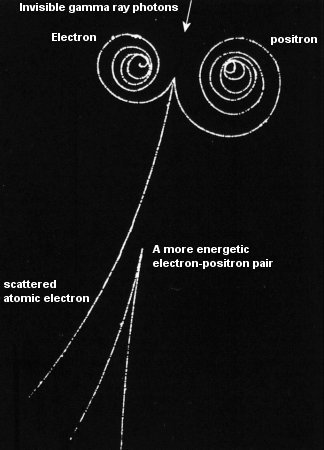-
Posts
916 -
Joined
-
Last visited
-
Days Won
3
Content Type
Profiles
Forums
Events
Everything posted by martillo
-
I agree, the only consideration I can make is that the electric potential energy is a constraint in the minimum separation distance at which the pair is created as the energy tends to infinite as the distance tends to zero. At least we agreed in that the pair of charged particles must be created at some distance apart. I just will stay wondering how that can happen starting from a single and neutral photon particle (interacting with an atom, I know).
-
I agree they are not created at zero distance and of course I know about Heisenberg uncertainty. I agree in that I don't know how the principle could apply in the determination of the distance and how it can be related to the energy involved to separate them apart. I never saw this subject be treated anywhere. Can you explain that or do you have some reading to suggest? The calculation I made is that as the electric potential energy of the pair electron-positron is kq1q2/r = (ke2)/r and the energy tends to infinite as the distance tends to zero.
-
Which is the right picture then? Please explain.
-
Right. How they are modeled? Please explain. Not point-like particles lead us to think in particles with possible structures (spatial dimensions, shape, etc.) even for the elementary particles like the photon and the electron.
-
Right. The two possibilities, design or no design, lead us to some unanswerable fundamental question.
-
The three particles, the photon, the electron and the positron are currently modeled as point-like particles. The problem arises at considering how, from the one single point of the photon, the other two points fo the electron and the positron surge. If they appear existing in a too close distance the energy needed to separate them apart is too high. Remember that the electric potential energy is inversely proportional to the distance between the pair: kq1q2/r = (ke2)/r. A too high energetic photon would be needed to produce the pair in that case. The problem is how two points with opposite charge appear into existence at some proper distance from a single neutral point. At zero distance the separation energy would be infinite. Other subject would be how the charges are created but this is another topic.
-
Of course I know about the called "wave-particle duality". I'm considering the particle-like behavior now. If you know the process of conversion of a photon to a pair of electron and positron integrating some concept of waves please explain. I'm focusing in the electric energy involved in that process. If in the process the electron and the positron get too close then a too big electric energy would be involved.
-
What is a photon then? Does it have spatial dimensions? If it has no spatial dimension it is well called "point-like particle".
-
The electric potential energy of the electron-positron pair vary from zero at an infinite distance increasing as they get closer but even at distance about their wavelength the energy would be negligible. I have made the calculation and at such distance the energy is only about one in a thousand of their individual rest energies. The problem is for instance in the pair production from a gamma ray photon. If a photon is considered a point-like particle how it can produce a pair of electron and positron well separated enough. If they are too close the electric energy between them would be too big. I'm thinking now that actually the process of conversion photon-pair is actually something unknown, is that right?
-
I agree that considering all the things that happen in the world and the universe the conclusion would be that they weren't made with any intelligent design except for the case if, for some reason, something went wrong in the creation and/or development of the universe and things are not as they were planned to be. This lead to a possible not so perfect entity of course and to big discrepancies with any religion I know. I'm not religious at all but I don't discard the possibility of some design. I believe in some kind of "deism" in opposition to any "theism". A question surges for the no design at all approach: how the physics' laws come into place? All theories of the beginning of the universe start under the consideration of some physics' laws even at the initial state and the question arises: how are the physics laws developed?
-
Two particles of opposite charge attract themselves. It is necessary energy to separate them apart. This is something that appear to not be considered in fundamental well known particles interactions like the free neutron beta decay and in the positron-electron pair creation. In the energies' balances are only considered the rest energies of the particles and not the energy between the two particles separated apart. I think this energy is not negligible at all, on the contrary, at subatomic scale the particles can be very close and the electric potential energy between them could be very high. I don't understand why this subject does not appear in any energy balance of experimental particles' interactions anywhere. From Wikipedia for instance: 1) Free neutron decay (https://en.wikipedia.org/wiki/Free_neutron_decay) : "For the free neutron, the decay energy for this process (based on the rest masses of the neutron, proton and electron) is 0.782343 MeV. That is the difference between the rest mass of the neutron and the sum of the rest masses of the products." 2) Pair production (https://en.wikipedia.org/wiki/Pair_production) : "As energy must be conserved, for pair production to occur, the incoming energy of the photon must be above a threshold of at least the total rest mass energy of the two particles created."
-
Hiding tubes connecting the hollows. May be in some magic trick.
-
... Fine if your intention is just to represent all rational numbers. A different story is to represent the physical Space of the Universe.
-
In a) which would be the finite size of the steps? In b) it would depend if the space is infinite or finite.
-
Seems it all depends in how you define the steps or the resolution of the grid.
-
I think it would depend on how the grid is defined. For instance could be a grid in steps of 1/3 or whatever 1/n with integer n. Some rational numbers could apply in a grid while others don't. But of course an entirely integer grid could in principle be possible too. As @joigus said may be is something undecidable for us.
-
I agree. +1 Except if the space be actually discretized in a grid with some imperceptible resolution. In this case places represented by irrational numbers would not really apply.
-
Yes, in the case of a discrete grid the number of the steps in any finite time would be finite, countable. If there's no grid, the movement is continuous and can be thought as in uncountable infinitely small steps.
-
Could a difference be in if there exist a grid on the space or not? I mean, a difference would be if the movement of the particles would be in discrete steps or continuous.
-
Someone said otherwhere the "proper time" is the same for any observer. Can it be said that "proper space" is also the same for any observer? Then would follow that "proper space-time" is always just an Euclidian flat space and an absolute time the same as in Classical Physics. The "space-time curvature" would be just apparent to the observers. The problem with this is that Relativity Theory becomes just an "apparent theory" describing things that actually does not take place anywhere. This is not what is sustained by the mainstream. It is said for instance that time dilation is real with the example of the muons' decay as an experimental proof for RT. Something does not match to me here...
-
Thank you, martillo. We agree in some things while disagreeing in the end: I don't believe any possible ether solves the things, I think in a complete new theory or model on an empty space. I think the current theories are true only in part and wrong in other parts. The big challenge is to build the puzzle with all the right parts only. The try on "welding" them is a dead end row for me.




